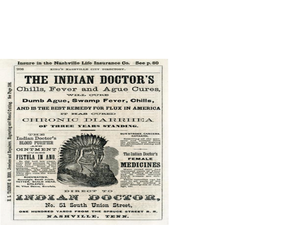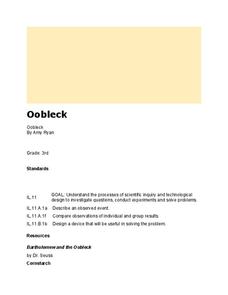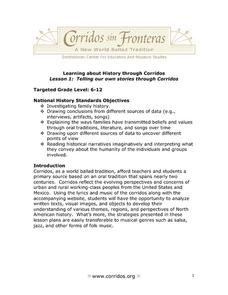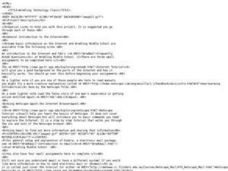Curated OER
Don't Drink To That!
Students simulate the effects of alcohol on their vision and motor skills. Then, after doing additional research on the dangers of driving while intoxicated, students create an educational activity that might convince a particular target a
Curated OER
Fantastic Journeys
In this activity, students will design a theme park attraction based on a fantastic journey from literature, film, or their own imaginations.
Curated OER
Worksheet for Analysis of an Advertisement
Students critique advertisements in magazines, newspapers and telephone books. In this advertising lesson, students complete a class activity in which they locate specific advertisements, then answer questions that analyze the...
Curated OER
Evaporation
Fourth graders study the water cycle and the different processes involved, specifically evaporation. They explore the processes of evaporation through hands-on collaborative activities and relate learning to life through...
Curated OER
Bar Codes
Middle schoolers identify five good qualities of a friend, four helping activities and carry out an activity to help a friend.
Curated OER
Building a Better Sentence
Sentence construction is both a science and an art. This bare bones lesson ties an analysis of earth's geology to sentence formation. Although referenced as a major part of the activity, there are no links to the technology or resources...
Curated OER
Authentic Assessment/ Lab Practicum (Video format)
Students are given this authentic assessment format after the study of any laboratory activity (or group of labs). It's purpose is to replace the lab practicum when it is not possible to do a real set-up and /or to serve as a make-up...
Scholastic
Presenting Persuasively (Grades 9-12)
As a review of persuasive techniques, groups develop a one-sentence slogan designed to entice others to purchase a produce or adopt a point of view. The group then craft a storyboard for a commercial for their product.
EngageNY
Group Discussions and Revision: Editorial Essay
Great minds think aloud! Pupils participate in the Fishbowl protocol, discussing their opinions about the Mary River mine proposal. As they share their thoughts, peers provide feedback about their thesis and supporting ideas.
Smithsonian Institution
What's the Code? Coding Robot Movements Using Sound
Tap into the desire to learn about computer codes. Pupils apply the Tap Code and the Polybius Square to send secret codes using sound. They design a code that tells a robot what movements to make and then test out their code using one of...
Childnet International
Responding to Cyberbullying
After watching a short video about cyberbullying, individuals play an online cyberbullying game and then create their own Digizen that expresses their values and presents their vision for themselves, their friends, and the world at large.
Stanford University
Solstice and Equinox Season Model
How can December 21 be the shortest day of the year when all days are 24 hours long? Pupils see how to build a model showing the differences between winter and summer solstices and equinoxes. Using this model, classes can then discuss...
Google
Interland
"Be Internet Awesome" is the motto in a super cool digital citizenship interactive created by Google. Interland is made up of four lands that explore the importance of digital safety and helps young Internet users to be alert, strong,...
Curated OER
Get To Know Your Classmates
Fifth graders participate in an introduction activity in which they make a PowerPoint presentation. They work with a partner to include the partner's background and hobbies in the presentation.
Curated OER
Magazine Dollars and Sense
Students analyze magazine advertisements that appeal to them. They explore how tobacco companies continue to target teens in magazine advertisements. They explore how advertisers select magazine ad space.
Curated OER
Campaign Songs as Propaganda:Free Trade vs. Protectionism - In Whose Interest?
Students analyze campaign messages about tariffs in a 19th-century campaign song. They read and discuss the lyrics, complete an analysis worksheet, and identify the intended audience of the song's message.
Curated OER
Times of Day
Learners practice telling time using a foreign language. In this time telling activity, students listen to a teacher tell them the time in their target language as they translate it while writing. Learners utilize their new...
Curated OER
The Writing Process
Students engage in the various steps involved in the writing process. The lesson plan is written as a guide for the teacher to write more in depth lesson plans for specific activities. This is a good model plan to follow.
Curated OER
Koala Bear Exhibit
Learners visit the zoo and study the koala bears. In this habitat lesson, students take a field trip to the zoo and examine the habitat of the koala bears. Learners watch videos about koalas and consider the needs of the koalas....
Curated OER
Oobleck
Students explore "matter." In this literacy and three states of matter activity, students listen to Bartholomew and the Oobleck by Dr. Seuss, then work in groups to explore "oobleck" (cornstarch and water mixture) with their five senses....
Curated OER
Write Picture Captions
Students notice and investigate a large range of devices for presenting texts-captions. Students write original captions for several audiences. Students write a fictional news story based around a certain caption.
Curated OER
Taking a picture Walk
First graders use question words to answer comprehension questions. In this reading strategies lesson, 1st graders use picture cues and predict events in a story. Students use context clues to understand unfamiliar words....
Curated OER
Passing Down Family History Through Oral Tradition: Corridos
Students create and perform Corridos which are oral tradition ballads. In this Passing Down Family History Through Oral Tradition instructional activity, students interview family members using a predetermined list of questions. In...
Curated OER
Project Description
Pupils engage in using the Internet to solve problems. The skill of problem solving is developed and technology skills are used to solve a student picked problem. The lesson targets the middle school audience.























